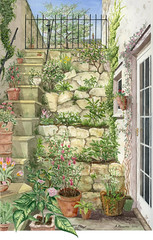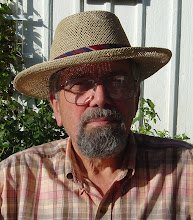WARNING:
To anyone who has been to Art School, or been involved in fine arts for a while this will probably be old hat. Read no further. You must excuse me. But for those of us who are self-taught, haven’t yet achieved much, and are groping our way towards an understanding in this discipline, matters of colour, hue, shade and value need exploring. I find that putting my thoughts on paper helps me. Whether it is helpful to others is open to question.
I climbed onto my exercise bike again today and started off.
‘What shall I think about today?’ I asked myself. Wrong. Well, … actually, there’s nothing wrong about choosing a subject and thinking about it. The process will most likely lead to a workmanlike solution to whatever the problem was. But that isn’t what I’m after. I don’t have a particular problem or research topic that needs addressing in that way. I’m anticipating,… what? The insights that sometimes come when the mind is free. Was yesterday just a one-off? I think maybe the Buddhists have it right; the trick is, to empty the mind.
It’s windy today; and bright. Partly cloudy. I look out the window. The sun is going in, coming out; playing with the colours. The wind is from the southwest and strong; must be a cold front on the way. Zero at the moment, it’ll probably be colder later. The air is crystal clear.
When the sun is out, the colours are perfectly saturated, when it goes behind a cloud the colours are not just darker, they are duller. And the colour of the shadowed boards under the eaves of my neighbours house is not the same hue as the boards lit by the sun. Why is that? It occurs to me that this de-saturation has basically just a straight inverse relationship to the amount of ambient light. At night, everything is in greyscale, black, grey and white. You can easily explore the effects of desaturation in ‘Photoshop’. Open any picture in this program, and then click on the ‘brush’ tool, or the ‘paintbucket’ on the toolbar at the left side Now pick up a nice colour from your photo by clicking the mouse with the ‘Alt’ key held down. This colour will show as ‘Foreground’ colour in the little square. Now click on that square to ‘Choose Foreground colour’. This will bring up a small page, with your colour marked by a little circle. Drag the little circle straight up towards the top of the page (totally saturated) or straight down towards the bottom (totally desaturated). Notice in the ‘selected colour’ window, how the hue has actually changed. I am trying to figure out why this is. Going back to the shaded board versus the sunlit ones, partly it must be because the sun is lighting up the bright boards with a unique spectrum, or mixture of light wavelengths. The shadowed board, on the other hand, is lit by light reflected from other surfaces, (clouds, buildings) or light from the ‘blue’ sky. So the end result, light finally reflected into the eye of the beholder, is actually a reflection modified from a quite different spectrum. So it makes sense that the perceived colour should change I suppose. But then again, 'Photoshop' doesn't know the unique conditions in which this colour is presented, so there must be more to it than that.
Colour is not as solid, real and defined as I used to think. It’s partly subjective. Different people see colours differently. Even the
same person can see colours differently. I learned this one night when I was flying a 767 over the Atlantic. Sitting quietly in the dark, the First Officer an indistinct shadow beside me. Checking the instruments, making position reports; steadily proceeding towards Europe. The lights turned low, so we’d notice anything outside, untoward or not; the cockpit bathed in a soft reddish glow from the instrument lights. One of the instruments, a distance measuring device with LED readout, was a little brighter than the others. It caught my attention as being different. How different? Something about the colour. I studied the numbers. What was it? I looked away, to one side, as I had been doing when I first noticed the difference. The colour changed! I looked back; it reverted. I closed one eye and looked – the light was red. I opened that eye and closed the other. The light was orange! I was getting two distinctly different colour interpretations of the same thing! Very strange. This condition did not present any difficulty, nor was I particularly worried about it. The anomaly stayed with me, on and off, several years. When I would wake up in the morning, the bedpost would appear reddish-brown through one eye, yellowish brown through the other. Now remember, I was a pilot. My eyes were regularly checked, including a test for colour vision. I never had any trouble interpreting the colour charts and reading the numbers. I have perfect colour vision. But? My wife will often see something as a brown colour, that I see as a shade of green; (this in connection with the colour of my trousers). I am merely illustrating here that colour can be interpreted differently. It is not simply a matter of wavelength; it has, for want of a better word, flavour.
Now value; that’s something else, and just as difficult sometimes. Is the blue sky lighter or darker than the sunlit building? Sometimes I really struggle with that. No matter how much I narrow my eyes and squint, I find it hard to decide. Somewhere I read, or heard, the suggestion that the artist should try to assign a lightness/darkness value to each component of their painting on a scale of one to ten. This makes sense, but is again often harder to assess in practice than in theory. Here again, ‘Photoshop’ can come to the rescue. Open a picture and ‘Remove Colour’ so you can see it in greyscale. That’ll tell you.
All this makes leads me to think about the colour sources we use when painting pictures. Some are purer and more reliable; others, less so. Upon reflection, I consider that the two best sources for colour are – the Mind, and the Real World. That is to say, your imagination or what you actually see. Depending on the subject and type of painting, either one of these would be the best bet. For myself, I have to say that my imagination is not as fertile as I would wish, and so making a sketch in ‘Plein Air’ is, ideally, the way I like to go. However, the limitations there are clear: the light is always changing, the weather may be inclement, and you may simply work so slowly as to make this impractical. So what’s next? Oftentimes you end up working from a photo, but this is third-hand colour at best. What I mean is, firstly, the camera interprets the colours. - Recently I was in a camera store, looking to upgrade my digital camera; (these days, you have to change cameras at more or less the same time interval as you change computers). With the bewildering numbers of choices on offer, I asked the manager for his advice. Well, he said, I like Nikon. Why?, I asked. I like the colour better, came the answer. That set me back for a moment. Until then I had not considered that different manufacturers, using differing technologies may end up presenting subtly different colours, depending on the algorithms used. That’s the first divergence. Next is the printer. It too has to measure the colours and values, and decide how best to reproduce them. Thirdly, the ink and paper selected will in turn present a slightly different and unique resultant print. Now you are looking at the print in order to copy it. What kind of light are you working under? Sunlight?, indirect daylight?, incandescent?, fluorescent? (I hope not!). By the time you lay the brush on the paper, you may be a long way removed from the original colour. You can shortcut some of these problems by working from an image on the computer monitor instead of from a print. I prefer this as next best to ‘Plein Air’, but it also presents problems. Is it convenient to paint where your computer is located?
But take heart. Finally, I am learning to trust my instinct, and gain confidence in my painting by constantly reminding myself that the picture is just a
representation! In the end, it doesn’t matter which colours are chosen, so long as they provide a happy and recognizable result.
Whoa – thirty minutes already today? Heart rate is up; aerobic effect achieved. Time to climb down off the bike; go and have a shower.













